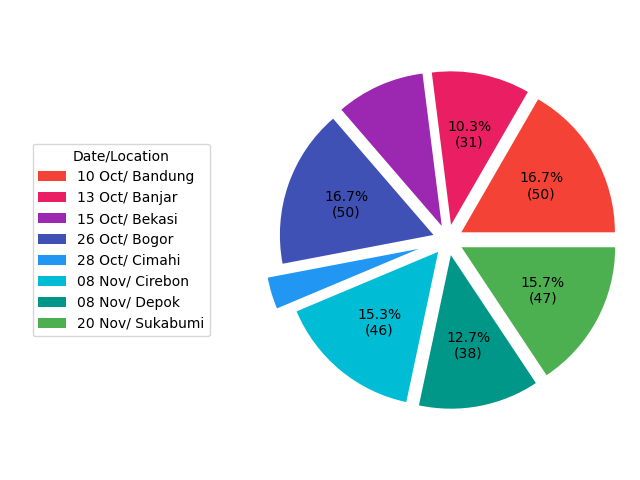Preface
Goal: Conclude the pie chart view.
Let’s make things complex.
1: Modularizing
Before we begin, we need to separate reusable code, into different script.
colors.pyhelper.pytrainees.py
So we don’t have to retype all the time.
Colors
# dict { color name: rgb code }
material_colors = {
'red500' : '#F44336',
'pink500' : '#E91E63',
'purple500': '#9C27B0',
'indigo500': '#3F51B5',
'blue500' : '#2196F3',
'cyan500' : '#00BCD4',
'teal500' : '#009688',
'green500' : '#4CAF50',
'lime500' : '#CDDC39',
'orange500': '#FF9800'
}
colors = list(material_colors.values())Helper
# additional function
def wedge_text(percent, total):
absolute = int(round(total*percent/100))
if percent > 10:
return "{:.1f}%\n({:d})".format(percent, absolute)
else:
return ""Trainees
# dict { location : (trainee, date, additional data) }
response = {
'Bandung' : (50, '10 Oct', 0.1),
'Banjar' : (31, '13 Oct', 0.1),
'Bekasi' : (28, '15 Oct', 0.1),
'Bogor' : (50, '26 Oct', 0.1),
'Cimahi' : (10, '28 Oct', 0.2),
'Cirebon' : (46, '08 Nov', 0.1),
'Depok' : (38, '08 Nov', 0.1),
'Sukabumi': (47, '20 Nov', 0.1)
}
elements = list(response.values())
trainees = [el[0] for el in elements]
date = [el[1] for el in elements]
explode = [el[2] for el in elements]
legends = [
"%s/ %s" % (value[1], key)
for key, value
in response.items() ]
total = sum(trainees)2: Data Test Bed
Combine All
Consider combine all the script above
import numpy as np
import matplotlib.pyplot as plt
from colors import *
from trainees import *
from helper import wedge_text- Beware that we have a longer legend text.
Matplotlib
The chart code, is very similar with the previous one. With little differences.
# plot pie chart
axes = plt.subplot()
wedges, texts, autotexts = axes.pie(
trainees,
labels = None,
colors = colors,
explode = explode,
autopct = lambda percent: wedge_text(percent, total))
axes.legend(
wedges, legends,
title="Date/Location",
loc="center left",
bbox_to_anchor=(-0.6, 0.5, 0, 0))
axes.set_position([0.4, 0, 0.6, 1])
plt.show()Wwe have a longer legend text. So we need to create more space
axes.set_position([0.4, 0, 0.6, 1])Since we use bbox_to_anchor setting.
the setting should also be changed.
bbox_to_anchor=(-0.6, 0.5, 0, 0)Chart Result
The chart result is drawn as expected. It is shown in figure below:

3: Chart Decoration
We can add more chart decoration such as title, suptitle,
and also a few enhancement.
Title and Suptitle
This line below is self explanatory.
plt.suptitle("Participants in West Java Region",
horizontalalignment='center',
weight="bold",
fontsize=12)
plt.title( "Respondent = %d Trainees" % total,
horizontalalignment='center',
fontsize=9, y=-0.1)
plt.show()Positioning
Since we add more object, we need more whitespace. So we should set the chart positioning again.
axes.legend(
wedges, legends,
title="Date/Location",
loc="center left",
bbox_to_anchor=(-0.6, 0.5, 0, 0))
axes.set_position([0.4, 0.1, 0.6, 0.9])More Parameters
For learning and curiosity purpose, I add more paramater:
wedges, texts, autotexts = axes.pie(
trainees,
labels = None,
colors = colors,
explode = explode,
startangle=30,
pctdistance=0.75,
textprops=dict(color="#212121"),
autopct = lambda percent: wedge_text(percent, total))Chart Result
Now we can see the result:

All done properly.
4: Fancy Piechart
We can go further with visual.
Original Article
I found this amazing article, by Kevin Amipara.
We need to achieve the same effect.
Subplots instead of just subplot.
Wait…! Is this a plural form?
Since we need to draw object in figure, we need to change a little bit from:
# plot pie chart
axes = plt.subplot()Into this form:
# plot pie chart
fig, axes = plt.subplots(figsize=(8, 5))With this form we can make multiple chart. But in this case. Just drawing a circle.
Drawing Circle
The code is almost verbatim copy carbon, taken from the original article.
#draw circle
centre_circle = plt.Circle((0,0),0.80,fc='white')
fig = plt.gcf()
fig.gca().add_artist(centre_circle)Instead of explaing the code here. You’d better read the original article.
Adjustment
We need to make a few adjustment as usual, so we can have proper chart.
wedges, texts, autotexts = axes.pie(
trainees,
labels = None,
colors = colors,
explode = explode,
startangle=30,
pctdistance=0.5,
textprops=dict(color="#212121"),
autopct = lambda percent: wedge_text(percent, total))
axes.legend(
wedges, legends,
title="Date/Location",
loc="center left",
bbox_to_anchor=(-0.6, 0.5, 0, 0))
axes.set_position([0.4, 0.1, 0.6, 0.8])Chart Result
Finally, the fancy chart.:

This works require creativity. And of course, imagination.
What is Next 🤔?
After pretty pie chart, we can continue to cumulative bar chart.
Consider continue reading [ Matplotlib - Bar Chart - Part One ].